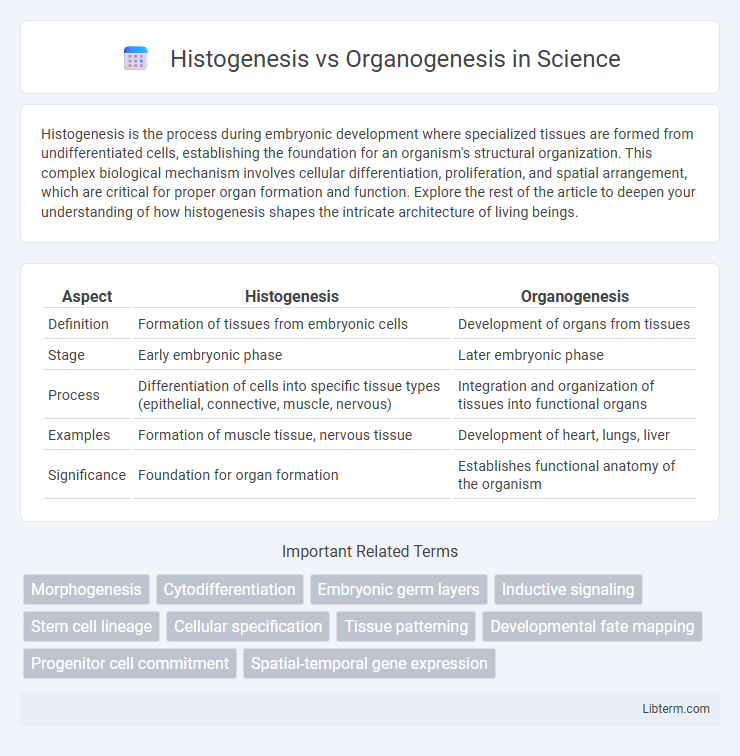Histogenesis is the process during embryonic development where specialized tissues are formed from undifferentiated cells, establishing the foundation for an organism's structural organization. This complex biological mechanism involves cellular differentiation, proliferation, and spatial arrangement, which are critical for proper organ formation and function. Explore the rest of the article to deepen your understanding of how histogenesis shapes the intricate architecture of living beings.
Table of Comparison
| Aspect | Histogenesis | Organogenesis |
|---|---|---|
| Definition | Formation of tissues from embryonic cells | Development of organs from tissues |
| Stage | Early embryonic phase | Later embryonic phase |
| Process | Differentiation of cells into specific tissue types (epithelial, connective, muscle, nervous) | Integration and organization of tissues into functional organs |
| Examples | Formation of muscle tissue, nervous tissue | Development of heart, lungs, liver |
| Significance | Foundation for organ formation | Establishes functional anatomy of the organism |
Introduction to Histogenesis and Organogenesis
Histogenesis refers to the process through which undifferentiated cells develop into specialized tissues during embryonic development, forming distinct cellular structures vital for organ function. Organogenesis involves the subsequent organization and differentiation of these tissues into fully functional organs with specific physiological roles. Understanding histogenesis is crucial for comprehending the cellular basis of tissue formation, while organogenesis highlights the complex morphogenetic events that establish organ architecture and interrelationships.
Definitions: Histogenesis vs Organogenesis
Histogenesis refers to the process by which undifferentiated cells differentiate into specialized tissues, forming the basic structural components of the body. Organogenesis is the subsequent developmental phase where these tissues organize and integrate to form functional organs. Both processes are essential stages in embryonic development, with histogenesis establishing tissue identities and organogenesis creating complex organ systems.
Embryological Stages Involved
Histogenesis involves the differentiation of mesenchymal cells into specific tissue types during early embryonic development, primarily occurring after the formation of the three germ layers in the gastrulation stage. Organogenesis follows histogenesis and encompasses the complex process of tissue assembly into functional organs, typically taking place during the third to eighth weeks of human embryogenesis. These stages are critical for establishing the structural foundation necessary for subsequent fetal growth and development.
Key Molecular Mechanisms
Histogenesis involves the differentiation of cells into specific tissue types guided by signaling pathways such as Wnt, Notch, and BMP, which regulate gene expression and cellular fate. Organogenesis relies on intricate morphogen gradients, including Sonic Hedgehog (Shh) and Fibroblast Growth Factors (FGFs), coordinating the spatial and temporal development of organ primordia. Both processes depend on transcription factors like HOX genes and epigenetic modifications to ensure precise tissue patterning and organ formation.
Major Differences in Developmental Processes
Histogenesis involves the formation and differentiation of specific tissues from the embryonic germ layers, while organogenesis refers to the development and organization of these tissues into functional organs. During histogenesis, cellular specialization and tissue patterning occur, establishing the structural framework, whereas organogenesis integrates multiple tissues, forming complex organs with distinct physiological functions. The key difference lies in histogenesis focusing on tissue-level development and organogenesis encompassing the assembly and maturation of entire organs.
Cell Differentiation in Histogenesis
Histogenesis involves the differentiation of unspecialized cells into specific cell types, forming the basic tissues of the body such as epithelial, connective, muscle, and nervous tissues. During histogenesis, genetic and molecular signals guide stem cells through stages of commitment and maturation to produce functionally distinct cells with specialized structures and functions. Organogenesis follows histogenesis by integrating these differentiated tissues into complex organs, coordinating cellular interactions and morphogenetic processes.
Organ Formation in Organogenesis
Organogenesis involves the precise differentiation and spatial arrangement of cells to form specific organs during embryonic development. This process coordinates cell signaling, morphogenesis, and tissue interactions to establish functional structures such as the heart, liver, and kidneys. Organogenesis relies on gene regulatory networks and morphogen gradients to ensure proper organ size, shape, and specialization.
Regulatory Genes and Signals
Histogenesis involves the differentiation of cells into specific tissue types guided by regulatory genes such as HOX and PAX families, which control cellular identity and spatial patterning. Organogenesis requires more complex signaling pathways, including Wnt, BMP, and FGF signals, orchestrating the coordinated growth and morphogenesis of multiple tissue layers into functional organs. Both processes rely on tightly regulated gene expression networks and signaling gradients to ensure proper development and structural organization.
Clinical Relevance and Medical Implications
Histogenesis involves the differentiation of cells into specific tissue types, which is critical for understanding congenital tissue malformations and guiding regenerative medicine therapies. Organogenesis, the process where organs form from multiple tissue layers, has direct clinical relevance in diagnosing and managing developmental disorders such as congenital heart defects and neural tube anomalies. Insights into these processes enable advancements in prenatal diagnostics, targeted interventions, and tissue engineering for organ repair and transplantation.
Future Directions in Developmental Biology Research
Future directions in developmental biology research emphasize advancing single-cell sequencing and live imaging techniques to elucidate the precise molecular mechanisms driving histogenesis and organogenesis. Integrating multi-omics data will enable a deeper understanding of cell fate decisions and tissue patterning, facilitating the development of regenerative medicine and organ regeneration strategies. CRISPR-based gene editing and synthetic biology approaches promise to unravel complex gene regulatory networks, accelerating the engineering of functional tissues and organs.
Histogenesis Infographic

 libterm.com
libterm.com